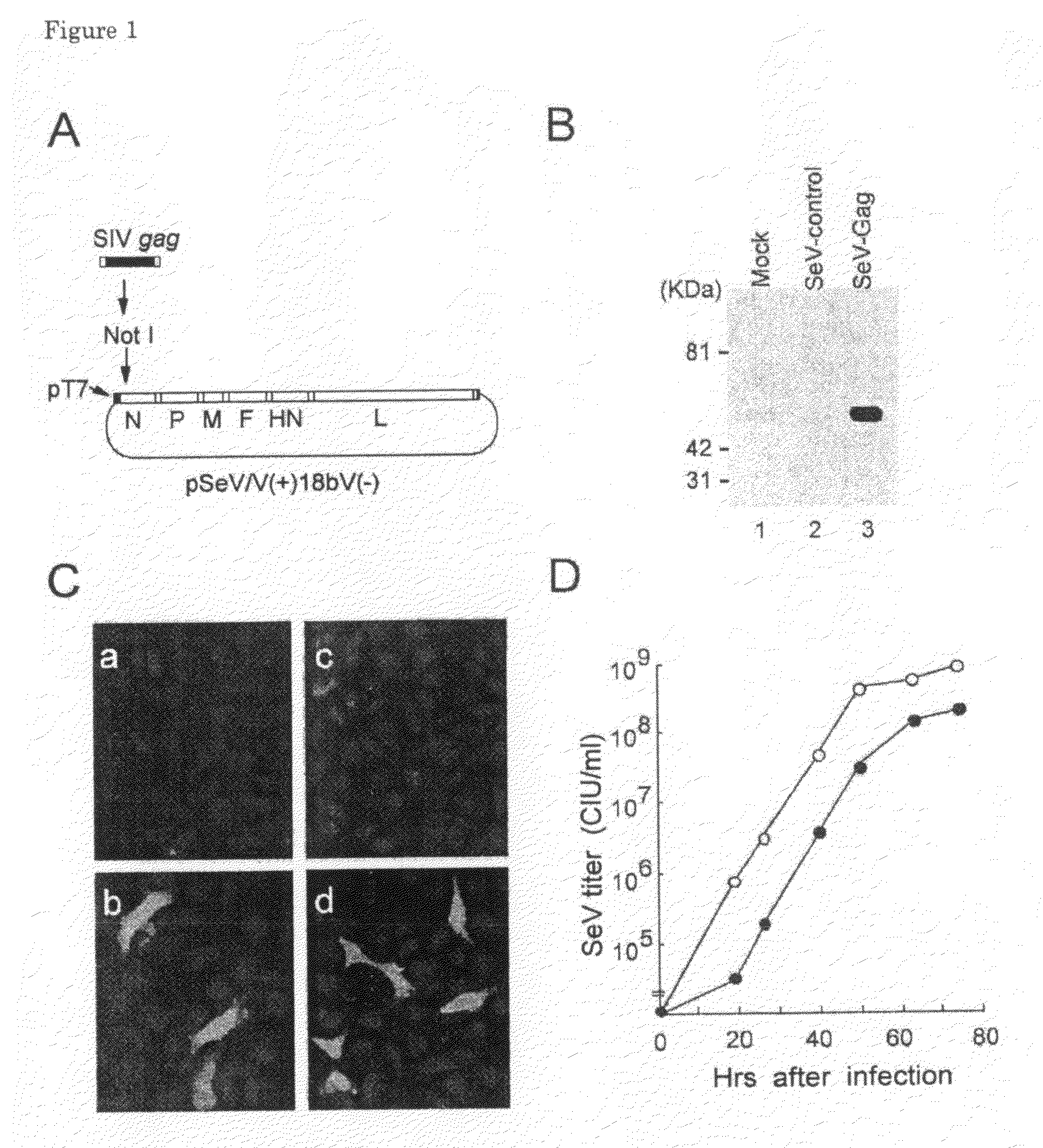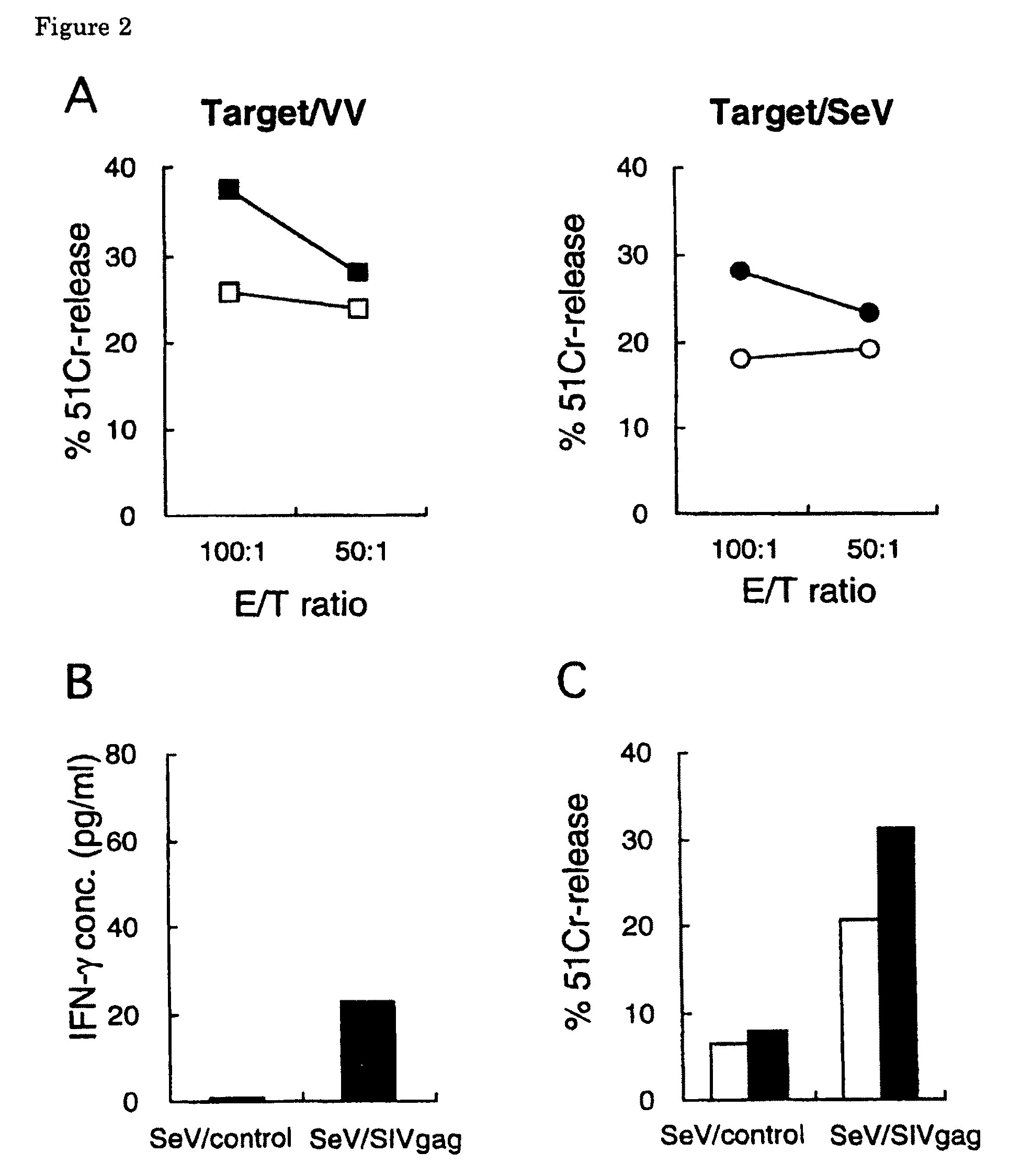AIDS virus vaccines using Sendai virus vector
a virus vaccine and sendai technology, applied in the field of aids virus vaccines using sendai virus vectors, can solve the problems that the attempts to use these vectors have failed to elicit sufficient protective immunity against hiv, and achieve the effect of efficient antigen expression and efficient induction
- Summary
- Abstract
- Description
- Claims
- Application Information
AI Technical Summary
Benefits of technology
Problems solved by technology
Method used
Image
Examples
example 1
SeV / SIVgag Collection
[0128]By using a safer V knock-out version of SeV (V[−]SeV) (Kato, A. et al. 1997. J. Virol. 71:7266-7272; Kato, A. et al. 1997. EMBO J. 16:578-587), we constructed a recombinant SeV vector expressing SIV Gag, SeV / SIVgag. Knock-out of the V gene, an accessory gene in SeV, by recombinant technology remarkably attenuated SeV pathogenicity for mice without disturbing viral gene expression and replication in cultured cells. A plasmid, pSeV(+)18bV(−), containing a full length of the attenuated V-defective SeV genome cDNA was described before (Kato, A. et al. 1996. Genes Cells 1:569-579; Hasan, M. K. et al. 1997. J. Gen. Virol. 78:2813-2820). Agene fragment encoding SIVmac239 Gag (nucleotides 1306 to 2845 [GenBank accession number: M33262] (Kestler, H. et al. 1990. Science 248:1109-1112)) was prepared by PCR amplification and introduced into pSeV(+)18bV(−) to obtain pSeV(+)18bV(−) / SIVgag. Primers used for the PCR are 5′-AAG CGG CCG CGA GAT GGG CGT GAG AAA CTC CG-3′ (S...
example 2
SIV Gag-Expression Using SeV / SIVgag In Vitro
[0129]Infectious SeV / SIVgag was rescued from the plasmid, pSeV(+)18bV(−) / SIVgag (FIG. 1A), according to a standard transfection protocol (see Example 1). Cells were infected with this SeV / SIVgag, and the expressed proteins were analyzed as follows. For harvesting cell lysates, CV-1 cells were seeded at a density of 4×105 cells per well in 6-well plate, grown overnight, and then infected with SeV / control or SeV / SIVgag at m.o.i. of 5. One day later, the cells were lysed with 600 μl of lysis buffer (50 mM Tris-HCl, pH 8.0, 150 mM NaCl, 0.02% sodium azide, 0.1% sodium dodecyl sulfate, 0.5% sodium deoxycholate, 0.1 mg / ml phenylmethylsulfonyl fluoride, 1% Triton X-100). For each lane, 10 μl of cell lysate was loaded. Western blot analysis using a monoclonal mouse anti-p27 antibody was performed as described (Matano, T. et al. 1993. J. Virol. 67:2026-2033). Immunostaining was performed by using the anti-p27 antibody and a fluorescein-conjugated g...
example 3
Induction of SIV Gag-Specific Cellular Response by SeV / SIVgag In Vitro
[0130]To examine whether SIV Gag-specific response is induced by SeV / SIVgag-mediated Gag expression, cellular immune response was tested in vitro using PBMC prepared from a rhesus macaque (Macaca mulatta). This rhesus macaque was previously vaccinated with a naked DNA expressing SIV antigens (a plasmid DNA expressing SIV antigen including Gag) and challenged with SIVmac239 for other experiments. The SIVmac239 challenge stock was prepared on rhesus macaque PBMC as described before (Kestler, H. et al., 1990, Science 248: 1109-1112; Shibata, R. et al., 1997, J. Infect. Dis. 176: 362-373). The infectious titer of the stock was assayed on MT-4 cells. These rhesus macaques were tested negative for SeV, SIV, and simian type D retrovirus before use and maintained in accordance with the institutional guideline for laboratory animals. Blood collection, vaccination, and virus inoculations were performed under ketamine anesth...
PUM
| Property | Measurement | Unit |
|---|---|---|
| concentration | aaaaa | aaaaa |
| concentration | aaaaa | aaaaa |
| concentration | aaaaa | aaaaa |
Abstract
Description
Claims
Application Information
 Login to View More
Login to View More - R&D
- Intellectual Property
- Life Sciences
- Materials
- Tech Scout
- Unparalleled Data Quality
- Higher Quality Content
- 60% Fewer Hallucinations
Browse by: Latest US Patents, China's latest patents, Technical Efficacy Thesaurus, Application Domain, Technology Topic, Popular Technical Reports.
© 2025 PatSnap. All rights reserved.Legal|Privacy policy|Modern Slavery Act Transparency Statement|Sitemap|About US| Contact US: help@patsnap.com



